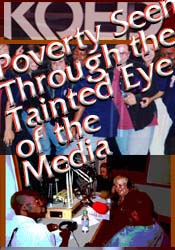|
by Connie Lu/PNN media intern
I enter KQED to attend a media salon focused on images of poverty in the media through large transparent glass doors. I
am amazed by the surrounding modern office furniture
and state of the art wide screen TV hanging on the
front wall of the room. I help myself to the
refreshments and to my surprise I notice a few bottles
of wine. Knowing that KQED is a "public" television
network; I expected a less extravagant atmosphere.
But aside from my misconceptions, I sit at a small
dark red table that is square-shaped with four
surrounding chairs, feeling unsure of what to expect
now, after my initial inclination was proved wrong.
But despite this feeling of uncertainty, I am
comforted by familiar faces from POOR Magazine.
Lisa Gray-Garcia aka Tiny, Co-Editor with Dee Gray of POOR
Magazine, is asked to speak first. She shares about
her struggle with poverty and how POOR Magazine was
established. She stresses the fact that low-income
people never get heard in mainstream media. The media
portrays the homeless as nuisances that are associated
with drugs and mental illness. However, POOR Magazine
does not see the homeless as outsiders, outcasts, or
the "other". This concept originated from Dee and is
the foundation that POOR is built upon.
Although I had heard POOR's mission statement before,
it did not feel redundant to me at all. Each time I
hear about the essence of POOR Magazine, I am reminded
of my purpose of being at POOR, which is to empathize
and find personal connections to the inspiring people
I write about. POOR Magazine writes in first person
because the article becomes more real and genuine.
Through empathy the writer is connected, which gives
the reader this same mutual experience. I do not see
those who are struggling with poverty as the "other",
but as my teachers.
Participating in the discussion at KQED also reminds
me of being in Community Newsroom each week at POOR,
which is where low-income people gather to be heard.
Both KQED and Community Newsroom consist of people
meeting together to express upon the issues of
poverty. However, I can not equate the two. At KQED,
there does not seem to be this feeling of being
connected, unlike the closeness I feel when I am at
POOR during Community Newsroom. The series of
comments made during the Media Salon seem unrelated at
times, which gave the impression that perhaps people
weren't really listening to each other. The comments
would often not link together in a natural flow of
discussion, but each point was made like kernels of
corn that randomly popped at the urge to speak.
However, at POOR each succeeding comment reflects the
genuine attention of the listener. Michael Isip,
Executive Director of KQED, has this same
characteristic of being a good listener. After
showing a documentary he is currently working on
called, "Hope on the Streets" he asks for constructive
criticism. As several opinions are being expressed,
he listens intently and writes them down. He felt
nervous showing his documentary after hearing several
comments about how the media's portrayal of the
homeless is tainted. However, Isip is eager to learn
and shows his gratitude for the suggestions.
The documentary focuses upon both homelessness and
mental illness. Through the documentary, Isip hopes
to convey a sense of hope for the homeless by showing
personal accounts of success from homelessness. The
purpose behind his documentary is to break stigmas and
stereotypes about the homeless because it prevents
them from asking for help. His goal is to educate
people about the homeless to increase awareness and
encourage out-reach to them. The documentary also
revolves around his strong belief that; "There is no
such thing as a throw away person".
The documentary shows the progress of a few homeless
and the success that is achieved in the end. A
homeless man named, John Joseph explains in the
documentary that he used to work on a ship, but was
then diagnosed with Acute Paranoia Disorder. He was
afraid of people and would seclude himself. He spent
four years sleeping in BART stations.
When Joseph mentions where he sleeps, my memory is
suddenly triggered to a homeless man I saw sleeping
against a pole at the BART station last month. I saw
him quietly sleeping. He was not disturbing anyone.
His black hat was low and covered his eyes. He wore a
backpack and a dark green jacket. But as I was
waiting for BART, I become alert to two policemen
walking towards him. The two policemen lifted the
homeless man up from the straps of his backpack. He
says something that I was not able to make out
clearly, but he sounded angry.
I felt as though I could have helped this homeless man
by waking him up and warning him that there were
policemen approaching. I worried about where he would
be taken and the pain he would suffer. I kept asking
myself why they wouldn't leave him alone because he
wasn't being disruptive or bothersome, but I continued
to watch in frustration as he was taken away.
The documentary then introduces another homeless man
named Jimmy, who asks a flower vendor named Byron
Yonandis, if he could help out at his flower stand.
Byron not only gives Jimmy the job, but he has given
Jimmy a sense of hope. He expresses his compassion
for Jimmy, who is now like a brother to Byron. There
is an incredible amount of trust between them. Jimmy
says when Byron leaves him in charge of the flower
stand, he "feels good".
I was amazed by the love in Byron's heart for Jimmy.
The empathy that Byron had was not only spoken through
his words, but also shown through his actions of
placing a genuine trust in Jimmy, despite the many
stereotypes against the homeless. As the discussion
came to an end, I recall images of Byron's face of
hope as I walk down the spacious hallway to meet the
cool night sky filled with glimmering stars. | 



